
Related
Guests
- Chung-in Moonprofessor of political science at Yonsei University in Seoul, South Korea, and editor-in-chief of Global Asia, an English quarterly magazine. He previously served in the South Korean government and twice met Kim Jong-il.
- Christine Ahnexecutive director of the Korea Policy Institute, a research and educational institute that promotes U.S. policies toward Korea in support of peace, reconciliation and the reunification of Korea.
North Korean state-run television announced Monday that longtime leader Kim Jong-il died Saturday at the age of 69, after reportedly suffering a heart attack while traveling on a train. Under his leadership, North Korea became a nuclear state and was widely known as one of the most repressive societies in the world. Kim Jong-il’s youngest son, Kim Jung-un, is expected to become North Korea’s new leader, but it is unclear if his ascendancy will bring about any real changes, as Kim Jong-il ruled North Korea in concert with a large circle of regime insiders who remain at the helm. We look at how the Korean Peninsula is the most militarized region on earth and what this means in this transition of power. “Given the past history of animosity and confrontation between the two Koreas, our government has taken precautionary measures to stabilize the situation,” says Chung-in Moon, professor of political science at Yonsei University in Seoul, South Korea, and former government official who twice met with Kim. Meanwhile, “there’s a kind of reverence for Kim Jong-il by the people, because the North Korean people have a deep sense of needing sovereignty and independence,” notes Christine Ahn, executive director of the Korea Policy Institute. She says North Koreans recall 35 years of Japanese occupation and were proud of “joining the nuclear club” in order to prevent what they perceive as U.S. military occupation and the division of the Korean Peninsula. [includes rush transcript]
Transcript
AMY GOODMAN: We turn now to the death of Korean leader Kim Jong-il. State-run television announced Monday he had died Saturday at the age of 69, after reportedly suffering a heart attack while traveling on a train. Known as the Dear Leader, Kim took over North Korea in 1994 following the death of his father, Kim Il-sung. The two men are the only leaders North Korea has known since the Korean Peninsula was formally divided in 1948.
Under Kim Jong-il’s leadership, North Korea became a nuclear state. In 2003, North Korea quit the Nuclear Non-Proliferation Treaty after the Bush administration refused to hold bilateral talks and uphold an agreement to supply light-water reactors. Three years later, North Korea tested its first nuclear device.
North Korea, under Kim Jong-il, is widely known as one of the most repressive societies in the world. While it was becoming a nuclear state, an estimated one million of its citizens died during a famine in the 1990s. The United Nations estimates at least 200,000 people have died or languished in a state security apparatus that includes forced labor camps, prisons and public executions.
North Korean authorities released video footage of dozens of mourners sobbing uncontrollably in a public square upon the news of Kim Jong-il’s death. Those images provided by North Korean state media.
South Korea put its military on alert following the news of Kim Jong-il’s death. Not long after, North Korea reportedly test-fired a missile off its northern coast. The two sides have technically been at war since the signing of the Korean armistice in 1953.
Kim Jong-il’s youngest son, Kim Jung-un, is expected to become North Korea’s new leader. But it’s unclear if his ascendancy will bring about any real changes. Kim Jong-il ruled North Korea in concert with a large circle of regime insiders who remain at the helm.
While the Obama administration has continued the Bush stance of refusing direct negotiations, it’s engaged with North Korea indirectly through the “six-party talks” alongside South Korea, Japan, China and Russia. In Washington, Secretary of State Hillary Clinton said the U.S. maintains hope for better relations with North Korea, but also concern for the plight of its people.
SECRETARY OF STATE HILLARY CLINTON: We both share a common interest in a peaceful and stable transition in North Korea, as well as an ensuring regional peace and stability. We have been in close touch with our partners in the six-party talks today. We reiterate our hope for improved relations with the people of North Korea and remain deeply concerned about their well-being.
AMY GOODMAN: For analysis on the death of Kim Jong-il and what it means for North Korea, the Korean Peninsula and the world, we begin our coverage in Seoul, South Korea, where we’re joined by Chung-in Moon, professor of political science at Yonsei University and editor-in-chief of Global Asia, an English quarterly magazine. He previously served in the South Korean government and was involved in diplomatic efforts with the North Korean government.
We welcome you to Democracy Now! Can you talk about the significance of the North Korean leader’s death and why South Korea is now on high alert?
CHUNG-IN MOON: But actually is very much a precautionary measure, because North Korea is going through the national mourning period, therefore North Korea is really obsessed with internal issues, therefore there’s no great threat coming from North Korea. But given the past history of animosity and confrontation between the two Koreas, our government has taken precautionary measures to stabilize the situation.
AMY GOODMAN: You actually met Kim Jong-il in 2000. Talk about the context of the meeting, and explain your—explain his significance in the Korean Peninsula.
CHUNG-IN MOON: I met him twice, one in 2000 and the other in 2007, during the two Korean summit talks. And I was very much impressed at the way he performed during those two summit talks. But he was a paramount leader of North Korea, and he was really dictating North Korean policy on South Korea, on the United States. Therefore, he has really unprecedented power in his hands. Therefore, he was dictating North Korean destiny, at the same time he was influencing inter-Korean relations. Therefore, I would say that he has a very important stature in the Korean history.
AMY GOODMAN: The intelligence services of South Korea, of the United States, of China, have been humiliated by what happened over the weekend. They did not know that Kim Jong-il had died until it was announced on—by the Korean media. What about the relationship between South Korea and North Korea? For people in the United States, although the U.S. is deeply involved in the militarization of the peninsula, the most militarized area on earth, there’s really very little knowledge about the Korean Peninsula, about what happens in North Korea, let alone South Korea.
CHUNG-IN MOON: During the past decade of the President Kim Dae-jung and President Roh Moo-hyun, there were quite high level of interactions between North and South Korea, therefore North Korean society was kind of exposed to South Korean society. But since the inauguration of President Lee Myung-bak, there have been very worsened relationship between North and South Korea. And there was the death of one tourist in Mount Kumgang area, and also there was the shelling of Yeonpyeong Island and torpedoing of our naval vessel. And all these things strained inter-Korean relations. And our government suspended all kinds of exchanges and cooperation with North Korea. But I think that has really delimited our access to intelligence in North Korea.
AMY GOODMAN: The fact that the Korean Peninsula is the most militarized area on earth—from your perspective in South Korea, Chung-in Moon, could you talk about the U.S. involvement in the region and how originally North and South Korea became separate countries?
CHUNG-IN MOON: When the Second World War was over, there was a so-called Yalta meeting. And in the Yalta meeting, there was a kind of tacit agreement between the United States and the Soviet Union to divide the Korean Peninsula. Therefore, Korean division was a direct product of the new beginning of the Cold War in 1945. And then, afterwards, the United States, as the occupation force in the southern part of the Korean Peninsula, returned the South Korean sovereignty to South Korean people. And on the other hand, North Korea was under the occupation of the Soviet Union, and the Soviet Union set up its puppet government in Pyongyang. And Kim Il-sung was the leader anointed by the Soviet Union. In that way, the Korean Peninsula was divided. In 1948, South Korea became the Republic of Korea as a sovereign—independent, sovereign state, and North was declared as the Democratic People’s Republic of Korea in 1948. That was a fixed division of the Korean Peninsula.
AMY GOODMAN: We’re going to break and then bring other guests into this discussion, from Amnesty International and the Korea Policy Institute. Our guest in Seoul, South Korea, Professor Chung-in Moon, h is professor of political science at Yonsei University and editor-in-chief of Global Asia, an English quarterly magazine, met with Kim Jong-il twice, in 2000 and 2007. This is Democracy Now! Back in 60 seconds.
[break]
AMY GOODMAN: Our guest in Seoul, South Korea, Chung-in Moon, professor of political science, Yonsei University, editor-in-chief of Global Asia, an English quarterly magazine, previously served in the South Korean government, where he was involved with diplomatic efforts and met with Kim Jong-il, who died on Saturday, they say at the age of 69, though others say he was 70.
Christine Ahn is joining us from the University of California, Berkeley, studios, executive director of Korea Policy Institute.
Christine Ahn, if you could continue with this history lesson that Professor Chung-in Moon began for us, especially for people here in the United States. You know the lack of geographical awareness of people here. We live in an insulated world—a globalized world, but we’re very insulated in the United States. What do you feel it’s most important to understand about North Korea in a global context?
CHRISTINE AHN: Thanks, Amy.
I appreciated Professor Moon’s brief history lesson, but I felt he kind of omitted a few key factors in explaining that very pivotal moment in Korean history. Yes, the Korean Peninsula was divided unilaterally, first by the United States and then with a sort of nod of agreement from the Soviet Union, but it also played a very critical role in installing a military government in South Korea. And since that period, since 1945, when it first landed in Incheon, it has had, you know, up to—you know, now it currently has 28,500 troops on the Korean Peninsula. But the part about South Korea’s democracy being really quashed, actually, for quite many decades, with the backing of the U.S., and I think that’s the bit of Korean history that Professor Moon had left out.
And the other bit about Korea that most Americans don’t realize is that the Korean War, which was the first Cold War, the front of the Cold War, and it continues to be the remaining war that has been unresolved, and I would say that it’s very crucial to understand that the fact that the Korean War has not ended has very much to do with the situation that North Korea finds itself in and the fact that it is still the most militarized region in the world.
AMY GOODMAN: Professor Chung-in Moon, would you like to respond?
CHUNG-IN MOON: Yes. There are good things and bad things. The United States has played some role in the Korean division, and also United States was—in part, was a patronizing military government in South Korea. But eventually, in 1987, South Korea achieved democratization, with a little help of the United States, by our own passion and power. Therefore, I think that the United States had some part in it, but I think the South Korean people have been able to achieve democratization. Since then, we have been achieving both growth and democracy in South Korea, even though there are temporal setbacks in our democratic movement.
AMY GOODMAN: Christine Ahn, if you could expand to talk about this issue of the Korean Peninsula being the most militarized region on earth and the issue of North Korea being a nuclear nation and what this means in this transition of power.
CHRISTINE AHN: Well, there are an estimated 1.2 million land mines still strewn across the Demilitarized Zone, across the 38th parallel. North Korea is—you know, I think that’s the mixed legacy of Kim Jong-il. And, you know, on the one hand, he inherited a very difficult situation in North Korea in 1994. The country had just—you know, with the passing of Kim Il-sung, which was the only leader that the country had known since 1945, 1948, and the fact that that country was undergoing tremendous, like, calamitous shocks, external and internal. 1994, it was on the brink of war with the United States. The Clinton administration was poised to strike its Yongbyon processing plant. It had endured serious serial droughts and harsh inclement weather that is very similar to the patterns of climate change that we’re seeing today, especially throughout Asia. And it had—it endured the collapse of the socialist trading bloc, so its dependence on not just exchange with China and the Soviet Union, but especially the import of fuel to just run basic things like the tractors to operate its agricultural system. And so, it endured a very difficult famine, and up to—you know, as you mentioned, up to a million people perished in that famine. And so, this was the period in which Kim Jong-il took over the reins.
And, you know, I think that it’s really critical to understand the kind of geopolitical context and the fact that North Korea has always viewed its engagement with the United States through the six-party talks as an opportunity to normalize relations, because they have viewed the engagement with the West and the normalization, especially with the United States, its historic enemy, as crucial for its economic recalibration. And unfortunately, whether it’s the Bush administration, whether it’s the Obama administration, or even the Clinton administration, it has always viewed North Korea as, you know, this basket-case country that is on the brink of collapse. And that has tremendous consequences, not just for peace on the Korean Peninsula or for the region, but for the very security and survival of the people of North Korea, who are struggling on a day-to-day basis to have access to food, to have access to electricity.
So, if I were to say one thing on this show, it’s, you know, we need to promote engagement, we need to promote dialogue, and that’s what we know works. As Professor Moon has mentioned, you know, in that period of Kim Dae-jung and Roh Moo-hyun, the previous presidents before Lee Myung-bak, there was a period of not just engagement between North and South Korean leaders and governments, but among civil society and families that have been divided, you know. I mean, there are millions of Korean families, especially here in the United States, who have still family in North Korea. So, I would say that this is an opportunity to—you know, we can conjecture all we want what’s going to happen to North Korea, and under the leadership of Kim Jong-un or the political elite, but what we can do is try to influence our political leaders to, you know, be in the spirit of engagement, direct dialogue and promotion of peace and reconciliation.
AMY GOODMAN: Christine Ahn, executive director of the Korean Policy Institute, can you talk about the significance of the nuclear bomb that North Korea has and how that really is what directs U.S. policy towards North Korea? And your sense of who Kim Jong-un, Kim Jong-il’s son, who is expected to succeed him, went recently with him on a trip to China, but very young, what—who he is and what the internal—the top circle in North Korea, how much power it wields versus what the son will wield?
CHRISTINE AHN: Well, Amy, sorry I got derailed there for a minute. But I would say that’s the mixed legacy of Kim Jong-il. I would say that the ordinary North Korean—I mean, and it’s so hard to tell. I mean, even the CIA says we don’t know what we don’t know about North Korea. But—and as you mentioned, you know, the intelligence failure, where most of the world didn’t even know that he had passed away two days after it had happened.
But the situation with Kim Jong-il is, you know, that the people were hoping for economic improvement in their day-to-day lives, and he was not able to see that through. And—but on the other hand, this is a perspective that I was able to get by traveling throughout North Korea, and it is that, you know, there’s a kind of reverence for Kim Jong-il by the people, because the North Korean people have a deep sense of needing sovereignty and independence. And that is because the birth of North Korea as a nation, you know, was essentially the result of resistance and revolution against foreign occupation, and that includes 35 years of Japanese occupation, but it also includes what they perceive as U.S. military occupation and the division of the Korean Peninsula. So, in some sense, there is a reverence for Kim Jong-il because he was able to acquire a nuclear weapon, and there was a pride that the North Koreans had about North Korea joining the nuclear club. And I think it’s important, though, to clarify that North Koreans, you know, don’t have that pride because they want to wield that nuclear weapon to threaten or terrorize the rest of the world, but I say that—in my conversations with the people of North Korea, it was that, you know, “We are lucky we have this, because we won’t be another Iraq. We won’t be another victim of U.S. military invasion.”
And, you know, the thing is, is that they are speaking from the lived experience. When I went to North Korea, others—I had a very interesting insight, where I would travel around the country, and with our guides, you know, they would always point to this building. This was a restaurant. It was, you know, a very ancient-looking Korean building. But it was—I was wondering, why are—why do they always keep pointing that building out? And the thing that was really surprising is that was the only building that remained since the Korean War. Otherwise, the rest of Pyongyang was essentially leveled. And that was because of the devastating air raids. More bombs were dropped in the Korean War than in World War II. Napalm was introduced. I mean, the U.S. bombed dams, which was considered a war crime under the Geneva Convention.
So, this is the kind of mindset, the kind of narrative, that is so deeply woven into the North Korean psyche. And I think that we have to understand that, as people in the United States, as a starting point to understand why in the six-party talks, why in the bilateral negotiations with North Korea, North Korea so desperately wants to build a relationship, and then they want to de-nuclearize, whereas the Obama, the Clinton, the Bush administrations have always viewed those fora to just disarm North Korea. And North Korea says, you know, “That’s not good enough. We need to have normalized relations. We need to have a peace treaty.” And that has been their stance, you know, starting from Kim Il-sung—
AMY GOODMAN: Christine Ahn—
CHRISTINE AHN: —through Kim Jong-il, and—yes.
AMY GOODMAN: As we continue our coverage of the death of Kim Jong-il, we wanted to look at his human rights legacy and what may lay ahead for his 29-year-old son Kim Jong-un, as he prepares to take power.

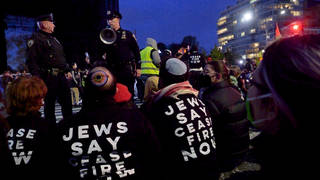
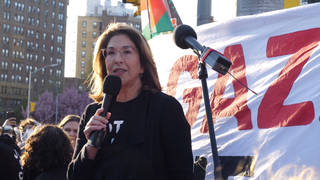
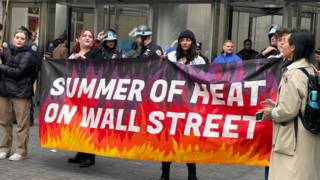
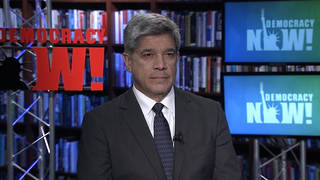





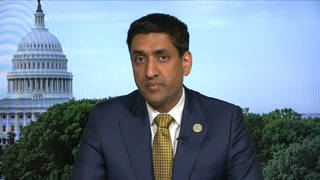

Media Options